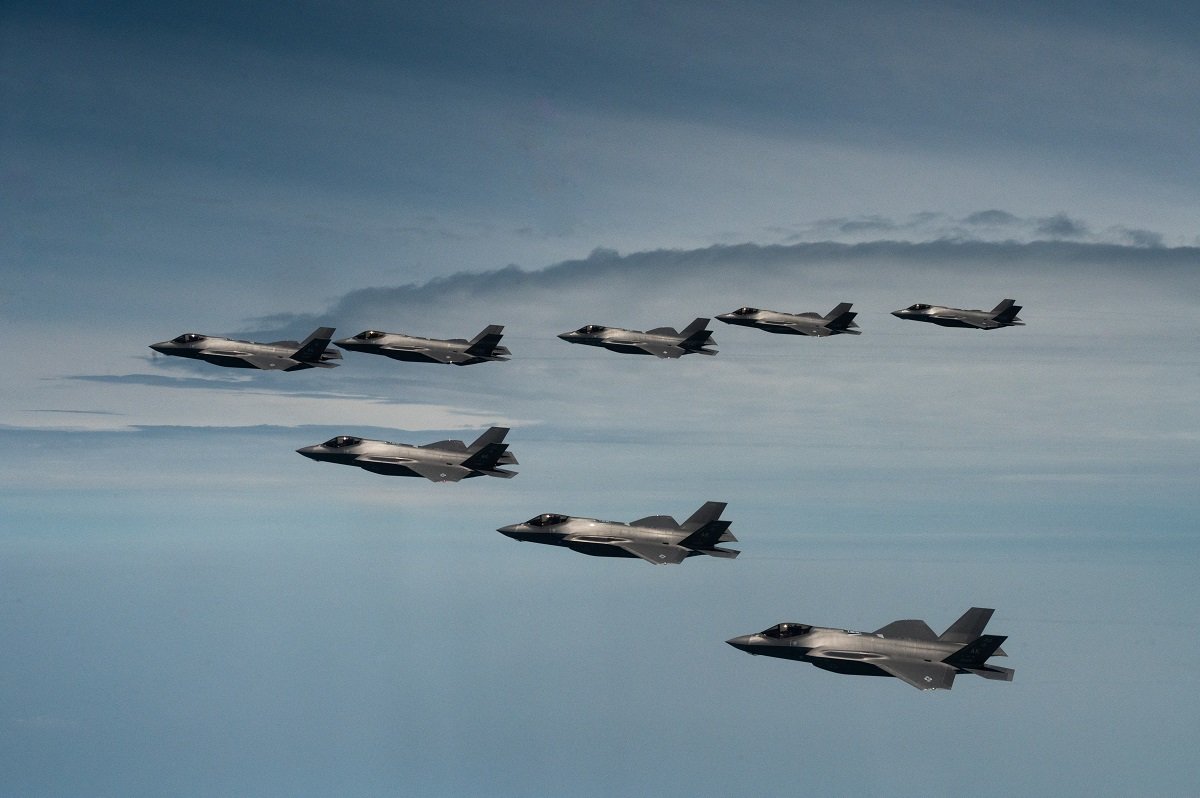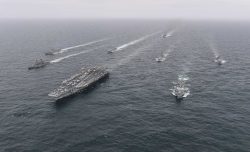
U.S. Air Force F-35 Lightning IIs fly side by side with South Korean Air Force F-35s as part of a bilateral exercise over the Yellow Sea on July 12, 2022.
19:22 JST, February 19, 2023
SEOUL (Reuters) – The United States and South Korea held a joint air exercise involving U.S. strategic bombers on Sunday, a day after North Korea fired a Hwasong-15 intercontinental ballistic missile (ICBM) in a “sudden launching drill.”
South Korea’s Joint Chiefs of Staff said the exercise, where South Korea’s F-35A, F-15K and U.S. F-16 fighters escorted American B-1B bombers, demonstrated the allies’ “overwhelming” defense capabilities and readiness posture.
“(The exercise) strengthened the combined operation capability and affirmed the United States’ ironclad commitment to the defense of the Korean Peninsula and the implementation of extended deterrence,” the South’s military said in a statement.
Japan’s Fuji News Network said Japan and the United States were also likely to conduct a joint air drill as early as Sunday afternoon.
The U.S.-South Korea exercise comes a day after North Korea launched a long-range ballistic missile into the sea off Japan’s west coast, following a warning of a strong response to upcoming military drills by South Korea and the United States.
North Korea’s state media KCNA said the country conducted a “sudden launching drill” on Saturday in an “actual proof” of its efforts to turn the “capacity of fatal nuclear counterattack on the hostile forces into the irresistible one.”
Leader Kim Jong Un’s sister, Kim Yo Jong, issued yet another warning and bristled at the United States for trying to turn the U.N. Security Council into what she called a “tool for its heinous hostile policy” toward Pyongyang.
“I warn that we will watch every movement of the enemy and take corresponding and very powerful and overwhelming counteraction against its every move hostile to us,” she said in a statement.
Saturday’s missile launch, the North’s first since Jan. 1, came after Pyongyang threatened on Friday an “unprecedentedly persistent, strong” response as South Korea and the United States gear up for annual military exercises as part of efforts to fend off the North’s growing nuclear and missile threats.
The North Korean state news agency said the missile had flown for 1 hour, 6 minutes and 55 seconds, as high as 5,768 km (3,584 miles), before accurately hitting a pre-set area 989 km (614 miles) away in open waters. Hwasong-15 was first tested in 2017.
Japanese said on Saturday the missile had plunged into waters inside its exclusive economic zone.
Nuclear-armed North Korea fired an unprecedented number of missiles last year, including ICBMs capable of striking anywhere in the United States, while resuming preparations for its first nuclear test since 2017.
South Korean Foreign Minister Park Jin said Saturday’s launch “clearly” signals the North’s intent to conduct additional provocations.
“If North Korea conducts the seventh nuclear test, which could happen at any time, it will be a game changer in a sense that North Korea could develop and deploy tactical nuclear missiles,” Park told the Munich Security Conference on Saturday.
The launch, guided by the Missile General Bureau, was conducted on an “emergency firepower combat standby order” given at dawn, followed by a written order from Kim Jong Un at 8 a.m. (2300 GMT on Friday), KCNA said. South Korea’s military said it detected the missile at 5:22 p.m. (0822 GMT)
“The important bit here is that the exercise was ordered day-of, without warning to the crew involved,” said Ankit Panda, a missile expert at the Washington–based Carnegie Endowment for International Peace. “The amount of time between the order and the launch is likely going to be decreased with additional testing.”
The military unit got an “excellent mark” over the drill and the North’s ruling party “highly appreciated the actual war capacity of the ICBM units which are ready for mobile and mighty counterattack,” KCNA said.
Analysts say North Korea is likely to conduct more weapons tests, including a possible new solid-fuel missile which could help the North deploy its missiles faster in the event of a war.
North Korea’s ballistic missile and nuclear weapons programs are banned under U.N. Security Council resolutions, but Pyongyang says its weapons development is necessary to counter “hostile policies” by Washington and its allies.
"News Services" POPULAR ARTICLE
-

American Playwright Jeremy O. Harris Arrested in Japan on Alleged Drug Smuggling
-

Japan’s Nikkei Stock Average as JGB Yields, Yen Rise on Rate-Hike Bets
-

Japan’s Nikkei Stock Average Licks Wounds after Selloff Sparked by BOJ Hike Bets (UPDATE 1)
-

Japanese Bond Yields Zoom, Stocks Slide as Rate Hike Looms
-

Japan’s Nikkei Stock Average Buoyed by Stable Yen; SoftBank’s Slide Caps Gains (UPDATE 1)
JN ACCESS RANKING
-

Keidanren Chairman Yoshinobu Tsutsui Visits Kashiwazaki-Kariwa Nuclear Power Plant; Inspects New Emergency Safety System
-

Imports of Rare Earths from China Facing Delays, May Be Caused by Deterioration of Japan-China Relations
-

University of Tokyo Professor Discusses Japanese Economic Security in Interview Ahead of Forum
-

Japan Pulls out of Vietnam Nuclear Project, Complicating Hanoi’s Power Plans
-

Govt Aims to Expand NISA Program Lineup, Abolish Age Restriction

























